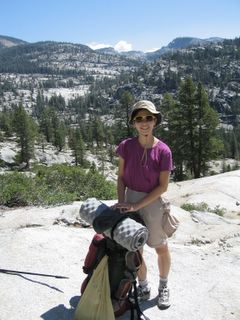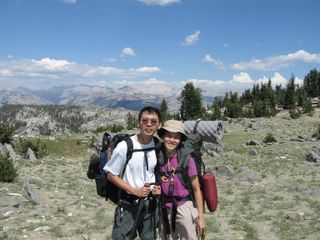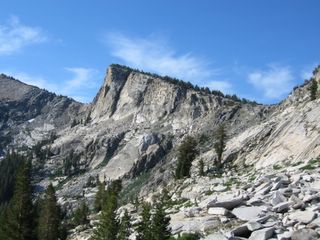Thursday, August 18, 2005
The next trip is likely to be an inn-to-inn walking trip in England's lake district. As usual, I'm starting out by planning this as a nice long walk, without any such distractions as museums or other cultural artifacts and let the folks who are coming along force me into visiting Wordsworth's birthplace or some such.
Suggestions, etc are welcome. And due to Lisa's school, the timing is forced: late May/early June. That makes planning and buying plane tickets easy.
Monday, August 15, 2005
Sunday, August 14, 2005
A few years ago, I read an article about climate change: the concern was that climate change might not be a continuous process as most folks might believe (naively), but that it could flip-flop between cold and warm states for unknown, chaotically driven reasons. I was extremely skeptical that such theories would in fact pan out, given the recent history of climate change, but this book (which is more about the theory behind abrupt climate change and less about the implications) shows how the theory has become more than just speculation and is now the primary theory behind the history of Earth's climates.
Of course, my pessimism about the human race says that we won't do anything about it until it's too late.
Down in the core below 2750 meters, in ice that the Europeans were confident represented the period of Eemian warmth about 120,000 years ago, oxygen isotope data showed two especially large and sudden plunges towards ice age cold. In one episode, average temperatures apparently plunged 25 degrees F for about 70 years. The only period of relative stability during the Eemian came during the last 2,000 years of its warmest stage.
"The unexpected finding that the remainder of the Eemian period was interrupted by a series of oscillations, apparently reflecting reversals to a `mid-glacial' climate, is extremely difficult to explain," the Euroepans wrote. "Perhaps the most pressing question is why similar oscillations do not persist today, as the Eemian period is often considered an analogue for a world slightly warmer than today's." Given the history of the last 150,000 years, they wrote, the past 8000 years "has been strangely stable."
Tuesday, August 09, 2005
This is probably the best financial book I've read all year. (Which doesn't say much, I admit) It's not for anyone who hasn't read any of the classics (like Malkiel's Random Walk Down Wall Street), but it's very much worth reading since even for those of us who have a decent mathematical background, interpreting the results of the mathematics in real world terms is a rare and useful skill, and Taleb has a good knack for explaining how to do it.
I have no large desires to sacrifice much of my personal habits, intellectual pleasures, and personal standards in order to become a billionaire like Warren Buffett, and I certainly do not see the point of becoming one if I were to adopt Spartan (even miserly) habits and live in my starter house... Becoming rich is not directly a moral achievement, but that is now where the severe flaw in the book lies.
Note: the book in question is The Millionaire Next Door.
After Lisa broke the camera on a sailing trip, I thought that was the end of it. My brother gave me the customer service # for Canon, and I called them. They gave me an address to send the camera to, I printed out the receipt (from Amazon.com), and sent the camera, box and all to them, expecting a hefty repair bill at the end.
I got the camera back yesterday. The lens unit had been replaced, the camera had been cleaned (though the scratches from my tour of the alps are still in evident, so it was clearly not a new camera), and the camera had been restored to working condition.
The charge: $0. They considered this a warranty repair.
Wednesday, August 03, 2005
You own a “Speed” poster on which your writing credit remains.
I do.
Was it a misprint? Was a teaser poster issued before the Writers Guild arbitrated that credit away?
It was “the” poster. And they put it out and then the arbitration happened kind of late. And so they pulled it and changed it.
So there are maybe a lot of those floating around out there somewhere?
I don’t know if they were actually up or if this was just the final mock-up. I just know that I have a copy of it. The arbitration was a great sticking point with me. I’ve always just disagreed with the WGA’s policy that says you can write every line of dialogue for a movie – and they literally say this – and not deserve credit on it. Because I think that makes no sense of any kind. Writers get very protective of themselves. They’re worried that some producer will want to add a line so he can put his name on it. But what they can do is throw writers at it forever without putting their names on it because of this rule. So I actually don’t think it works for writers. It certainly didn’t work for me.
Graham Yost [who received the sole screenplay credit for “Speed”] has always been very polite to me and very sweet but he did say to me, “You would have done the same thing.” And all I could say to him at the time was, “Well, I guess we don’t know if that’s true.” Because I’d never been in his situation. Then more than a year later John Lasseter called me and said, “I want to give all the animators who worked on the story credit on ‘Toy Story.’” And I said, “Sure.” And there are entire episodes of “Buffy” that I have written every word of that my name is not on. Which is gratifying to me because it means I finally have an answer to that. Which is, “No, I wouldn’t.”
Tuesday, August 02, 2005
My issue with the couplers are that they're expensive and take forever to use. My first tandem had couplers and disassembly took 2 hours (with two of us on it), and assembly took an hour. And this was after we'd gotten good at it! And of course, take pictures when you first get the bike or you'll never be able to pack it away in the boxes ever again!
Anyway, after I'd had enough of this, we finally sold the bike, and bought an uncoupled tandem. We took it to Europe, and this time, wrapped pipe insulation around the tubes and took it with us on the plane unboxed. They bent the deraileur hanger, which cost me 5 Euros and 15 minutes to fix at a local bike shop. On the way back I removed the deraileur and had no damage to the bike. Packing time: 5 minutes. Unpacking time: 5 minutes. (Removing and putting pedals back on) All through Europe the trains took our tandem and us, no problems. All the
hotels also found a place to keep our bike.
When we flew to Colorado last year for a tour, we had to box up the bike. On the way there, we got a Santana cardboard box (cost: $45), and took it with us on the plane ($80). Packing time: 20 minutes. On the way back, we rode to the Denver International Airport, bought 2
United Airlines boxes ($20), packed the bike there and then (20 minutes), and brought it back to San Jose International. The airline scratched the front saddle and gave us a $20 United airlines coupon for a minor scratch, we reassembled the bike (10 minutes), and rode
home. In Colorado we just kept our bikes in the hotel room with us.
Both my experiences travelling with the uncoupled tandem were superior to travelling with the coupled tandem in a hard case. We spent less time packing, and more time enjoying the biking. (but note: we don't have a carbon fiber bike --- those might be more fragile, in which case you might have no choice but to go S&S)
Finally, this year, I went to Europe again on my single. One of my friends brought a single bike with ritchey breakaway coupler. It took him more than an hour to assemble the bike! And more than 1.5 hours to take it apart at the airport. For myself, I would not pay the extra cost in either time or money, just to save the 15 Swiss Francs (30 for a tandem) it costs to take a bike on the train.
One of the couples in the club I'm in has both an S&S Santana and an uncoupled Calfee. They're signed up for 2 Erickson tours this September, and guess which bike they're bringing? The uncoupled Calfee. Even though they're retired and have lots of time, it's still less fun assembling and disassembling bikes than riding them, and they'd rather risk damaging their $10,000 bike.
I ran into a cyclist last year who said he surveyed every tandem couple he met while riding because he was shopping for a tandem. He said that whenever he asked about couplers for couples that had them, the usual response was "We thought they'd be a good idea, but we've
never used them." For those couples, maybe the cost of the couplers meant they didn't have any left over to take a vacation, but still.
There are a few good applications for couplers:
- Private plane owners. You're not going to fit a full sized tandem on a propellor plane, no matter what. (When travelling, every time I could have taken a prop plane I could also have taken a ferry, so it's not an issue that comes up unless you're a private pilot)
- Cruises. This was what S&S was designed for --- so you can bring your bike into your stateroom disassembled, get off the cruise boat, and assemble your bike and ride around town. A folding bike is probably cheaper for this task than adding S&S couplers to your Calfee.
- Frequent domestic flights. At $80 a pop, if you take 13 domestic flights, you've made back the cost of the couplers. ($2000 after you throw in the suit cases) Of course, after you've done the assembly once or twice, you might discover (as some folks I know did), that you'd rather *drive* to your domestic destination than go through the assembly/disassembly process again.
- You can't bear the thought of a $10,000 bike being protected by a $20 cardboard box, even though in my experience the $20 cardboard box in 10 years of travelling has never failed me.
[Update: there have been recent reports that even coupled S&S tandems are no longer escaping airline domestic charges. In addition, real world experiences have vindicated this article over and over again, as described in a later blog entry]
Saturday, July 30, 2005
An interesting book about how split-second decisions get made, how we are trained to use them, and how certain conditions (such as autism) might be due to the loss of ability to make those gut-level decisions. In the end, however, Gladwell does not succeed in tying all the threads of his explorations together, so the book feels quite disjointed.
When interviewing, in particular, it's important to not yield to the impulse to make a hiring decision based on first impressions --- those can be particularly misleading, so in interviewing, the scientific admonition to do your best to prove your intuition wrong is to be best followed.
How long, for example, did it take you, when you were in college, to decide how good a teacher your professor was? A class? Two classes? A semester? The psychologist Nalini Ambady once gave students three ten-second videotapes of a teacher --- with the sound turned off --- and found they had no dificulty at all coming up with a rating of the teacher's effectiveness. Then Ambady cut the clips back to five seconds, and the ratings were the same. They were remarkably consistent even when she showed the students just two seconds of videotape. Then Ambady compared those snap judgements of teacher effectiveness with evaluations of those same professors made by their students after a full semester of classes, and she found that they were also essentially the same
Friday, July 29, 2005
While musing about yesterday's topic, I realize that most of my truly life long friends (like Scarlet), are the ones who:
- Write back when you send them e-mail
- I've taken vacations with
It also partly explains why Europeans feel that Americans treat their relationships as superficial. If you haven't really experienced things together as friends, you're not really great friends, no matter how much you pretend like you are when you see each other.
Thursday, July 28, 2005
The typical American argues that it's better to have to work more than to have more vacation. The typical American doesn't even use all the vacation to which he is entitled, preferring to cash out those vacation days at the end of his tenure with the company. To what extent is this productive behavior, and to what extent is this leading the "life of quiet desperation" that Thoreau alludes to? Do Americans really value their families so much less that they would rather be in the office than spend time with their family?
After my recent trip in Europe, I had a few Google employees say to me that they wish they could have done something similar. To which, I said, "Why don't you?" The answer was invariably that they didn't have enough vacation. One of these employees was fully vested, so he was a multi-millionaire and could take unpaid leave if he wanted to. Others had other commitments with friends that meant that they would only spend a week or so in Europe, which I've explained is a very bad idea.
Google is one of the more generous employers when it comes to vacation time, but if even Google employees feel this way about vacations, what does that say about how less fortunate employees feel?
...according to the Organization for Economic Cooperation and Development, productivity in France - G.D.P. per hour worked - is actually a bit higher than in the United States.
It's true that France's G.D.P. per person is well below that of the United States. But that's because French workers spend more time with their families.
Because French schools are good across the country, the French family doesn't have to worry as much about getting its children into a good school district. Nor does the French family, with guaranteed access to excellent health care, have to worry about losing health insurance or being driven into bankruptcy by medical bills...
Perhaps even more important, however, the members of that French family are compensated for their lower income with much more time together. Fully employed French workers average about seven weeks of paid vacation a year. In America, that figure is less than four.
So which society has made the better choice?
Wednesday, July 27, 2005
But we did get the government we deserve. We voted the Republicans into the Congress, Senate, and White House. Who do we blame but ourselves?
And if you were president, and you had just seen more suicide bombs in London, wouldn't you say to your aides: "We have got to reduce our dependence on Middle East oil. We have to do it for our national security. We have to do it because only if we bring down the price of crude will these countries be forced to reform. And we should want to do it because it is clear that green energy solutions are the wave of the future, and the more quickly we impose a stringent green agenda on ourselves, the more our companies will lead innovation in these technologies."
How do I describe it. It's got that smooth, slightly pulsing feel at low speed, but what I'm really impressed by is how quiet it is when rolling with the lights on. I've used generator lights before, but mostly bottle generators, and they all make this little whine when spinning up. I had no idea how much of an impact that had on me psychologically! Even though resistance is higher when the light is turned on, with the generator hub I don't feel like it's slowing me down at all! (It costs about 1kph or so at most)
I have a nite rider light that's brighter at 6w, but the Shimano generator with the Lumotec light is more than bright enough, and doesn't burn out a $45 battery every year. So at $90, after 2 years it pays for itself (if I was willing to live with a 32h hub, I could have paid $60, but I had 36h rims sitting around and didn't want to stock more rims). There's also something nice about never having to plug it in, never having to charge it, and being able to just always leave it on the bike.








